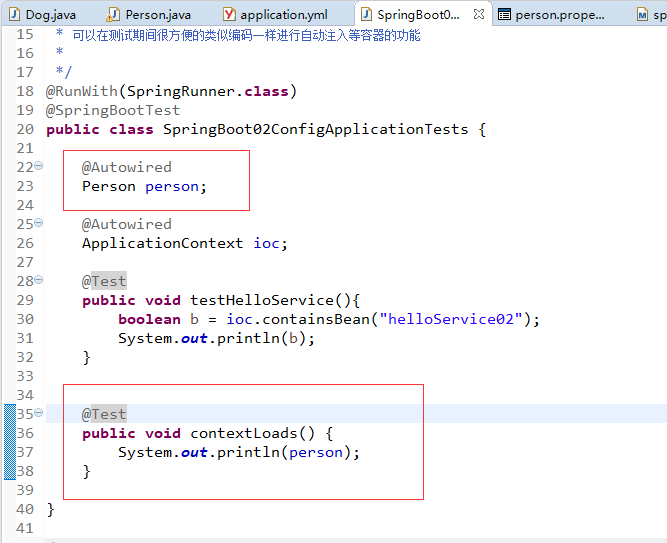首先让我想到的是spring的依赖注入,这里我们可以将yaml或者properties配置文件中的值注入到java bean中
配置文件
person:
lastName: hello
age: 18
boss: false
birth: 2017/12/12
maps: {k1: v1,k2: 12}
lists:
- lisi
- zhaoliu
dog:
name: 小狗
age: 12
javaBean:
package com.atguigu.springboot.bean; import org.hibernate.validator.constraints.Email; import org.springframework.beans.factory.annotation.Value; import org.springframework.boot.context.properties.ConfigurationProperties; import org.springframework.context.annotation.PropertySource; import org.springframework.stereotype.Component; import org.springframework.validation.annotation.Validated; import javax.validation.constraints.Null; import java.util.Date; import java.util.List; import java.util.Map; /** * 将配置文件中配置的每一个属性的值,映射到这个组件中 * @ConfigurationProperties:告诉SpringBoot将本类中的所有属性和配置文件中相关的配置进行绑定; * prefix = "person":配置文件中哪个下面的所有属性进行一一映射 * * 只有这个组件是容器中的组件,才能容器提供的@ConfigurationProperties功能; * @ConfigurationProperties(prefix = "person")默认从全局配置文件中获取值; * */ //@PropertySource(value = {"classpath:person.properties"}) @Component @ConfigurationProperties(prefix = "person") //@Validated public class Person { /** * <bean class="Person"> * <property name="lastName" value="字面量/${key}从环境变量、配置文件中获取值/#{SpEL}"></property> * <bean/> */ //lastName必须是邮箱格式 // @Email //@Value("${person.last-name}") private String lastName; //@Value("#{11*2}") private Integer age; //@Value("true") private Boolean boss; private Date birth; //@Value("${person.maps}") private Map<String,Object> maps; private List<Object> lists; private Dog dog; @Override public String toString() { return "Person{" + "lastName='" + lastName + '\'' + ", age=" + age + ", boss=" + boss + ", birth=" + birth + ", maps=" + maps + ", lists=" + lists + ", dog=" + dog + '}'; } public String getLastName() { return lastName; } public void setLastName(String lastName) { this.lastName = lastName; } public Integer getAge() { return age; } public void setAge(Integer age) { this.age = age; } public Boolean getBoss() { return boss; } public void setBoss(Boolean boss) { this.boss = boss; } public Date getBirth() { return birth; } public void setBirth(Date birth) { this.birth = birth; } public Map<String, Object> getMaps() { return maps; } public void setMaps(Map<String, Object> maps) { this.maps = maps; } public List<Object> getLists() { return lists; } public void setLists(List<Object> lists) { this.lists = lists; } public Dog getDog() { return dog; } public void setDog(Dog dog) { this.dog = dog; } }
上面用到了两个注解@Component和@ConfigurationProperties
package com.atguigu.springboot.bean; public class Dog { private String name; private Integer age; @Override public String toString() { return "Dog{" + "name='" + name + '\'' + ", age=" + age + '}'; } public String getName() { return name; } public void setName(String name) { this.name = name; } public Integer getAge() { return age; } public void setAge(Integer age) { this.age = age; } }
我们可以导入配置文件处理器,以后编写配置就有提示了
<!--导入配置文件处理器,配置文件进行绑定就会有提示--> <dependency> <groupId>org.springframework.boot</groupId> <artifactId>spring-boot-configuration-processor</artifactId> <optional>true</optional> </dependency>
运行springboot测试类



可见看到Person中的各种数据类型的值都获取到了